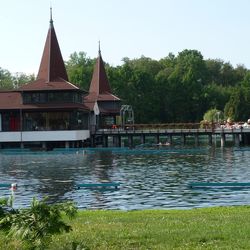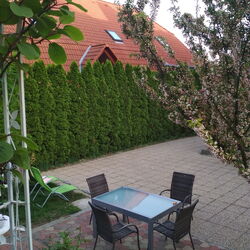

Honey, just as the bees made it
Did you know honey never really spoils? Its unique properties — high sugar content, low moisture, acidic environment, and natural antibacterial compounds — keep it preserved for years.
Honey is one of nature’s true treasures, and producing it is a privilege that requires dedication to the bees. Skapér Apiary, a family business in Zalaszentgrót, has been nurtured for generations. Today, it’s run by Zoltán Skapér, who brings over five decades of hands-on experience. For him, beekeeping is not a hobby but a way of life — a combination of work, responsibility, routine, and passion.
A second-generation beekeeper
Zoltán received his first hive as a child. Although he spent years in leadership roles in other industries, bees remained a constant presence in his life — first as a hobby, then a side activity, and eventually his main profession.
Following his father’s early passing, Zoltán took full responsibility for the family apiary and carved out his own path. Today, he not only produces honey but has also completed apitherapy training, operates one of Hungary’s first apitherapy houses, and mentors young beekeepers.
Bee-friendly beekeeping, naturally
Skapér Apiary produces classic varieties like acacia, linden, rapeseed, sunflower, goldenrod, and wildflower honey. But what sets them apart is not just the taste — it’s the approach. Zoltán practices mindful, nature-friendly, and bee-conscious beekeeping. He rejects chemical treatments entirely, using only natural substances like oxalic acid.
The wax in his hives is regularly replaced to prevent residue build-up, and its origin is always known, often recycled from his own operation. Before extracting, he measures the honey’s moisture content with a digital refractometer, ensuring optimal ripeness.
After extraction, the honey is left to settle for at least four weeks, allowing wax particles and air bubbles to naturally separate. It is then gently filtered through a 200-micron mesh, without additives, heat treatment, or anti-foaming agents.
Once bottled, the honey is left to rest a little longer, resulting in a clear, smooth, silky texture.
Apitherapy – Healing with bees
Beyond honey production, Skapér Apiary offers visitors a unique wellness experience.
Their apitherapy house is one of the first in Hungary, allowing guests to experience the therapeutic power of bees.
During a session, visitors relax on a special bed under which thousands of bees are working. The vibrations, warmth, hive air, and essential oils naturally support the body — helping with stress relief, respiratory issues, and sleep improvement.
Visitors can also book guided tours to learn about beekeeping, honey production, and see the hives up close in small groups.
Product Highlights
Acacia honey
One of Skapér Apiary’s signature products, this acacia honey is sourced from local forests growing on Zalaszentgrót’s clay-rich soils. This unique environment gives the honey its distinct flavor and color — ranging from pale yellow to a light green hue, depending on soil composition. Its taste is delicately sweet, with soft vanilla notes and a lingering floral finish.
Perfect for sweetening tea, lemonade, or coffee, spreading on toast, mixing into oatmeal, or as a baking ingredient. Plus, its natural antibacterial properties make it a healthful choice.
Where to buy
- 8790 Zalaszentgrót, Szabadság Street 86
- Google Maps
More information & Contact:
- Phone: +36 30 655 7701
- Apitherapy sessions by appointment
Did you know the Zala River once flowed into the Drava and only later “found” Lake Balaton? What sets the Quaternary Period (2.58 million years ago to the present) apart from earlier geological epochs is that the surface-shaping processes of this time — and the landforms they produced — continue to define our geographic environment today. One of the most pivotal surface processes during the Pleistocene (2.58 to 0.01 million years ago) was the migration of riverbeds and the formation of terraces and alluvial fans. These changes were closely tied to the slow retreat of the Pannonian Lake, which once filled much of the Carpathian Basin (see also: The Legacy of the Ancient Pannonian Lake). The early Danube initially flowed westward across what is now western Hungary, draining into the retreating Pannonian Lake. This westward course likely remained until the early Pleistocene. The most dramatic hydrological change in the Carpathian Basin occurred between the Pliocene and Pleistocene: the formation of the Danube’s Visegrád Gorge (today’s Danube Bend), which diverted the river toward the center of the country and what is now the Pest Plain. This shift profoundly affected all its former western tributaries — including the Zala. The river system of Central Transdanubia evolved in surprising ways, and the Zala’s journey is one of its most remarkable chapters. The Rába River already flowed northeastward toward the Little Hungarian Plain. The ancient Marcal, running northward, flowed into the Rába — and into it, in turn, flowed the ancient Zala. But nature redrew the map — using the Zala as its brush. A now-vanished river flowing from north to south (its remnants visible today between Zalaszentgrót and Zalavár) cut into the landscape through a process called headward erosion — where rivers erode backward into the terrain, much like a hot knife slicing through butter. Eventually, it cut into the ancient Zala’s valley and “captured” the river, diverting it into its own course. From then on, the Zala made a sharp turn south at Türje and — with no Lake Balaton yet in existence — initially emptied into the Drava. Later, as the depression that would one day become Lake Balaton deepened, the Zala was gradually drawn toward it. Lake Balaton, as a continuous body of water, is only about 5,000 years old — but for millions of years before, the Zala had already been on a winding journey that ultimately made it Balaton’s primary source of water, and the most life-giving river in the region today.
The history of western Hungary’s water systems is not just a fascinating geological puzzle — it reads like an epic of Earth history: riverbeds shift, rivers “consume” one another, and even Lake Balaton doesn’t enter the scene until the final chapter. Discover how nature reshaped this landscape stroke by stroke — and how the Zala became Balaton’s most vital source of water.The Quaternary Period and the Power of Landscape Formation
Pleistocene Changes: Riverbed Migrations and Terraces
The Ancient Danube Moves West
A River’s Great Turning Point
The Story of the Zala: Migration and Capture
A New Path — and the Birth of Lake Balaton













